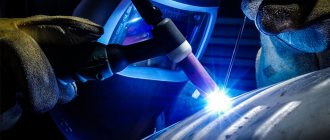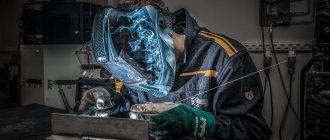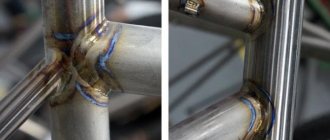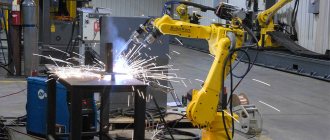The principle of argon arc welding is the melting of non-ferrous metal using a consumable or non-consumable electrode under the influence of an inert gas. The most common inert gas is argon, from which welding got its name, less often - helium and its mixture with argon. The most common type of non-consumable electrodes are tungsten rods, the diameter of which is selected according to the thickness of the metal being welded. These are all the basics with which any TIG welding training begins.
What should you consider when welding aluminum?
Welding aluminum is complicated by the specific properties of the metal. For a quality connection, the following nuances must be taken into account:
- Oxide film. It is formed when metal comes into contact with oxygen in the air. The problem is the large difference between the melting temperatures of aluminum and film: 650 and 2000 °C, respectively. As a result, the oxide remains in the weld, creating its heterogeneity. Aluminum can only be welded efficiently by removing the oxide and excluding contact of the metal with oxygen.
- Low melting point and high melt fluidity. It causes rapid flow of molten metal from the welding zone and through burning of the workpiece. Aluminum begins to enter the liquid phase already at a temperature of 500-520 °C.
- Increased volumetric shrinkage coefficient. An incorrect temperature regime causes stress to appear in the seam, which leads to cracking in it and the seam zone, as well as to deformation of the part.
- High thermal conductivity of aluminum. When welding, the loss of thermal energy increases significantly, which quickly spreads throughout the workpiece. This requires increasing the power of the device.
- Fast crystallization. This property of aluminum leads to the appearance of gas pores in the weld due to incomplete gas release during rapid hardening of the metal.
- Aluminum practically does not change color when melted, which makes visual control of the process difficult.
All these features should be taken into account by a novice welder. Setup requires special care.
Aluminum welding methods
Aluminum can be welded in several ways:
- Electrode welding (MMA). Electrodes used are UANA, OZANA, OZA-1 and -2, OK 96.10 and 96.50. The method is used in low-critical structures and with a metal thickness of at least 4 mm. The main disadvantage is insufficient uniformity of the seam, porosity, and reduced strength.
- Semi-automatic or electric arc welding. Wire with filler material is constantly fed into the welding zone. The connection is ensured by an electric arc. The oxide film is destroyed by cathode sputtering provided by alternating current or direct current with reverse polarity.
- Welding in argon environment. The most common method is argon arc welding. The gas creates an inert environment without oxygen, which eliminates the formation of an oxide film. An arc is ignited between the tungsten electrode and the workpiece. Aluminum wire is fed into the welding zone.
Interesting: What is direct and reverse polarity when welding with an inverter
The choice of method depends on the specific welding requirements and conditions, as well as the availability of the necessary equipment.
Welding features
TIG welding has its own characteristics
They need to be taken into account
- before welding, the metal must be cleaned and degreased;
- when processing parts, a connection to the negative pole is used;
- welding of aluminum parts must be carried out using alternating current;
- The wider the electrode element, the stronger the electric current should be. Do not overdo it, as the electrode may melt;
- The voltage of the electric arc depends on its size. Inexperienced workers are better off using a short arc;
- the end of the electrode should protrude 3 to 5 millimeters. If welding is carried out using the T-beam/angle method, the protrusion should be 5 - 8 millimeters;
- the gas must be evenly distributed over the nozzle section;
- the rigidity of the jet depends on the incoming gas;
- the electrode element must be moved from the right side to the left, longitudinally to the suture axis.
It becomes obvious that such TIG welding has many features. Because of this, it is not suitable for beginners.
Aluminum welding technology using argon
With the advent of modern equipment, argon welding has become widely available even for use in domestic conditions. It can be carried out in manual (TIG welding), semi-automatic and automatic mode. Step-by-step instructions will help you weld aluminum with argon for beginners; it will allow you to do everything correctly and efficiently.
What is needed for welding?
Equipment for welding aluminum
To weld aluminum with argon, a novice welder must prepare in advance:
- The current source is a TIG inverter.
- Special argon burner. It is advisable to insert a gas lens (collet holder) into it to purify the gas.
- An argon cylinder and a hose for connecting it to the burner.
- Filler wire. It is selected taking into account the grade of aluminum or alloy. For pure aluminum, rod No. 5356 is recommended; for aluminum with impurities, rod with silicon No. 4043 is recommended.
- Tungsten electrodes. Recommended brands: WT 20 (has a red tip), WC 20 (gray tip) or WL 15 (yellow tip). The minimum electrode diameter is 2.4 mm.
Important! The inverter should be selected with the following functions: non-contact ignition, crater filling, current regulation.
How to properly prepare aluminum?
High-quality welding of aluminum is possible only after careful preliminary preparation of metal blanks. First of all, it is necessary to clean the surface of the parts from dirt, grease, machine oils and oxide film. Mechanical and chemical cleaning methods can be used.
The mechanical method involves the use of sandpaper, a scraper or a wire brush. It is best to use a special brush for aluminum with stainless wires with a diameter of no more than 0.15 mm. It should not be used on other metals to avoid leaving particles on it.
Chemical cleaning can be done with alcohol, acetone or special solvents. This composition has proven itself well: a solution of sodium hydroxide (50 g) and sodium fluoride (45 g) in water (1 l). After treatment with this solvent, the surface remains clean for up to 4 days.
Immediately before welding, aluminum workpieces should be thoroughly heated (calcined). To do this, they are heated to a temperature of about 300 °C for 20–30 minutes.
Interesting: Description and types of welded joints
Preparations require the edges of the workpieces to be welded. If the metal thickness is more than 4 mm, they must be cut for butt welding. It is better to clean large irregularities with a grinder or file.
Preparing argon for welding
The preparation of argon for welding is important. The gas cylinder is installed at a safe distance and must be equipped with a pressure reducer. When purchasing, you should choose pure argon, without air impurities.
It is recommended to install a collet holder in the torch. It has a mesh that provides additional purification of the gas before it is supplied to the welding zone.
Gas flow is adjusted. It depends on the diameter of the filler wire. For Russian-made argon, the following flow rate is set: with a diameter of up to 1 mm - 12-14 l/min, with 1.2 mm - 14-16 l/min, with 1.6 mm - up to 22 l/min. When using Czech-made gas, the flow rate is 7–10 l/min.
Aluminum argon welding process
Tig welding scheme
A novice welder should follow these step-by-step instructions:
- After all the preparatory work has been completed, the selected electrode with a diameter of 2.5–5.5 mm is inserted into the burner. Its overhang should be about 2 mm. The key to ensuring the desired arc is good sharpening of the electrode.
- Excitation of the welding arc. The torch with the electrode is taken in the right hand, and the filler rod (wire) is taken in the left hand. The electrode is brought to a short distance to the surface of the workpiece (2–3 mm), sufficient for an arc to occur. You cannot touch the metal with the electrode, because... I'll have to sharpen it again. The torch is held vertically and the arc is directed towards the beginning of the seam. By changing the distance between the electrode tip and the metal, you can change the size of the arc.
- Formation of a weld pool. It is achieved by melting aluminum wire. It should be applied after ensuring a stable arc. It is generally accepted that the number of seconds required to form a weld pool coincides with the thickness of the workpiece (in mm).
- Formation of the weld. After the formation of the weld pool, regular wire feeding and smooth movement of the torch along the workpiece joining line are ensured. The electrode is held at an angle of 60-80°, and the filler rod - 10-30°. It is desirable that the angle between the torch and the wire is about 90°. The seam is formed according to the “drop by drop” principle, which means you need to ensure that they are distributed differently and are of the same size.
- Finishing the seam. The last stage is filling the crater. The main goal is to get rid of toxins. To do this, the wire feed is reduced and the speed of the electrode is increased. The weld pool should gradually disappear.
Important! The work is completed by checking the strength of the connection and visual control of the quality of the seam.
Rules for holding the electrode and filler wire
Welding work
Argon arc welding allows you to ensure high quality and strength of the connection Source triton-welding.ru
Like any work, the welding process begins with the preparation of tools and materials. The place where the seam will be located in the future must be cleaned of dirt and corrosion - a metal brush is usually used for this, and the quality of the weld will depend on the cleanliness of the edges (the absence of undesirable elements there). The filler rod is selected according to the thickness of the metal being welded. The workpiece is connected to the workpiece (crocodile grip), and the torch is connected to the TIG and through the hose to the cylinder.
Welding machine MIGOMAT 3in1 MIG 200 MMA TIG 200A MIG / MAG Source vroda.co.ua
There are several welding technologies, but they are mainly needed for industrial enterprises in the manufacture of parts with high precision parameters. Therefore, let’s pay attention to only two of them:
- TIG is a manual tungsten arc welding process where the filler is applied manually.
- MIG/MAG – automated consumable electrode welding (autofeed).
For such technologies, you can use units that support one thing, or you can use universal devices, for example, such as in the top photo. In any case, it will be very convenient for home use, as well as for a beginner (future) welding specialist.
Bar selection
BACX - chrome-plated stainless steel rods X20Cr13 (W1.4021), X46Cr13 (W.14034) Source smsurfo.ru
To fill the weld pool with homogeneous metal, special filler rods are used. Considering the fact that you have to work with different metals, the composition will be different. They can be classified according to homogeneous materials:
- stainless steel;
- aluminum and alloys;
- copper and alloys;
- nickel for cast iron.
Setting up argon welding for aluminum
Setting up the aluminum welding process includes the following steps:
- Setting up the welding machine. The following parameters are set on it: current balance with polarity setting (CLEAN WD.), welding current value (CURRENT), crater filling function (DOWN SLOPE toggle switch) or slow arc decay, gas purge function (POST TIME) for cooling the weld pool and torch .
- Setting up electrodes. The diameter of the electrodes and their projection from the burner are selected correctly.
- Argon flow setting. It depends on the diameter of the filler rod. When welding outdoors, consumption increases.
Interesting: Main types of metal welding
When setting the modes, the ratios given in the table are used:
| Thickness Al, mm | Current strength, A | Electrode diameter, mm |
| up to 1 | 30–42 | 1,6 |
| 1,1–1,5 | 46–60 | 2,3 |
| up to 2 | 71–80 | 2,3 |
| 3 or more | 90–300 | 3,2–5 |
It is necessary to configure equipment and modes with special care. It is better for novice welders to seek help from experienced specialists.
Features of the package
It is quite simple: you need a device to connect the mass and the burner - durable hoses, a reducer that provides regulation of the shielding gas pressure and is installed on a gas cylinder. There are two types of burners used:
- No. 1 - metals with a thickness of no more than 3 mm.
- No. 2 - for thicker structures.
The current value in the first option is not so large, so the body quickly cools down naturally; the second option uses water cooling: a mixture of alcohol-ethanol and distilled water circulates from the device to the burner, cooling the hose and body, and also protecting them from hypothermia in sub-zero weather .
Proper use of the inverter
When doing argon welding from an inverter with your own hands, it is useful for beginners to learn some nuances: first set the machine to the required amperage, connect the hoses. What matters is the type of current being connected, after which you need to adjust the gas supply, checking the table below.
| Gas consumption, l/min | Metals |
| 15—20 | aluminum |
| 10—12 | copper |
| 6—8 | low alloy steel |
| 12—14 | magnesium alloys |
| 10—12 | Nickel alloys |
The arc can now be activated and welding can begin, adding filler wire to improve weld quality.
The welder holds the torch at a certain angle, which allows him to visually correctly perform the metal connection.
We make the device at home
A simple way is to use a regular MMA inverter with parameters suitable for welding, but you need to modify and reconfigure it. As a result, you get an inverter unit that allows you to weld metal with any type of current connected. You will need a set of hoses to connect a factory-made burner, an oscillator and a current delay unit.
The second option involves making all the components of the circuit yourself - this reduces financial costs, but the performer requires knowledge and high skills in assembly, manufacturing complex circuit boards and parts, as well as a lot of free time.
Safety precautions
When carrying out work, it is necessary to take into account the presence of electric current, a bright glow of the arc, hot metal that can splash, and high temperatures. The welder must wear a special mask with a blue light filter. Gloves that protect your hands from melt splashes and clothing that can protect your entire body from them are required.
Electrical equipment must be reliably protected. It is necessary to use a residual current device and circuit breakers. The gas cylinder is equipped with a pressure reduction reducer. Before starting work, you must study the safety regulations and strictly follow them.
When welding aluminum one has to face difficulties caused by its specific properties. Argon welding, with the right approach and the use of high-quality materials and equipment, ensures a reliable connection.











